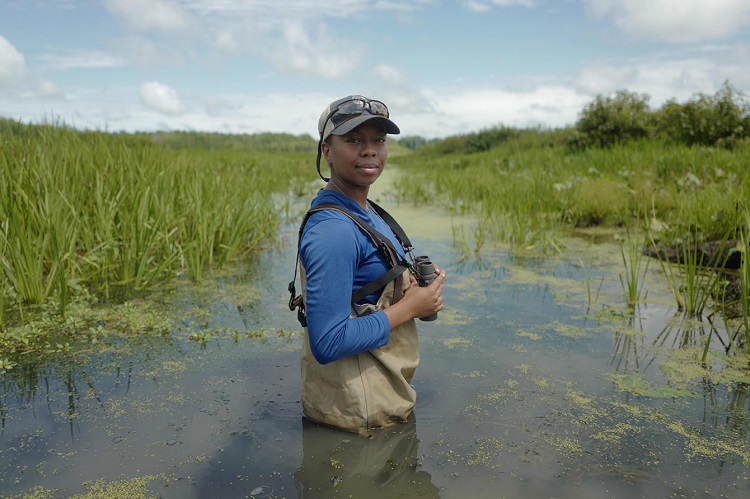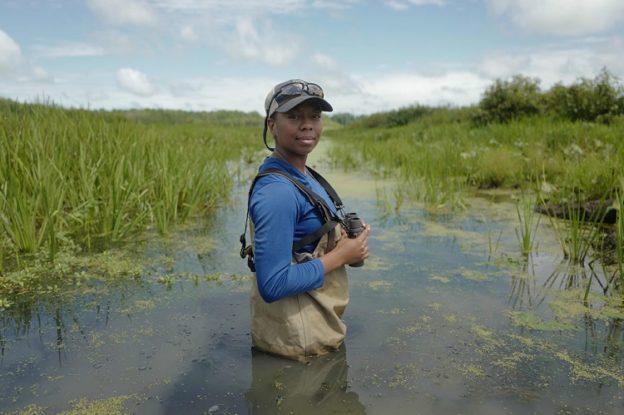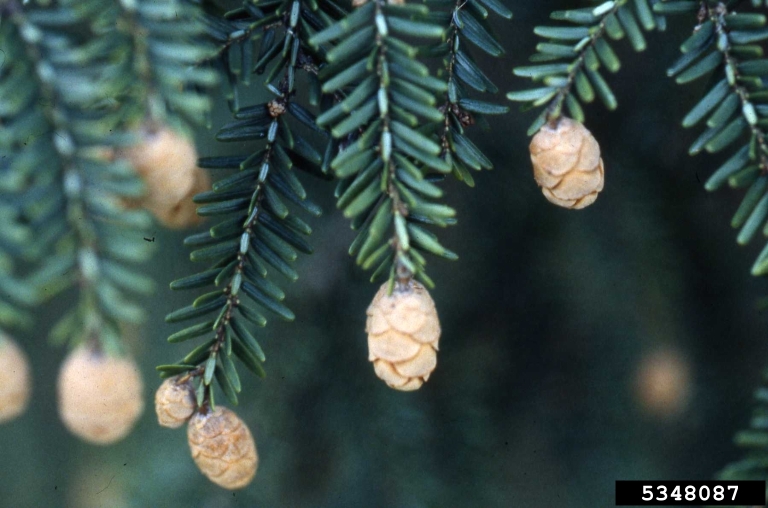Last week, Olivia Barksdale, Mass Audubon’s Conservation Restriction Stewardship Specialist, journeyed into Rutland Brook wildlife sanctuary in Petersham to talk about land, hemlock trees, and climate change.

An Overview of Hemlocks
Hemlock trees are evergreen conifers that are widely distributed across Massachusetts. They’re a long-lived tree, reaching up to 300-350 years old. You can find all sorts of critters thriving near hemlock trees, such as Red Efts (Eastern Newts in the middle stage, the “eft” stage, of their three-part life cycle) and Brook Trout.
Hemlock trees are our natural allies when it comes to adapting to impacts from climate change by buffering increasing storm events, providing shade from extreme heat, and even regulating water temperature and quality.
But these trees also need our help to combat the threats they face because of climate change. Eastern hemlocks are currently under attack by an invasive, sap sucking insect called the Hemlock Wooly Adelgid (HWA). Cold, hard winters typically lower the survival rates of HWAs, but climate change-induced milder winters are making more habitats suitable for these voracious bugs. The HWA can take down one ancient hemlock in as few as four years.
How can we Help?
By conserving land! Land conservation provides a wide array of services that help us, wildlife, and plants tackle the climate crisis. Protecting land preserves natural allies in our climate fight like hemlock trees, which not only help us adapt to climate impacts, but also mitigate climate change by soaking up excess carbon dioxide in the atmosphere. We need your help to maximize the climate impact of land conservation – join us in our collective climate fight by supporting one of our current, urgent land projects. You can make a difference.
Here were some questions we received about land, hemlocks, and climate change:
1. How will climate change impact the prevalence of different tree species in our forests?
As temperatures warm, trees can become stressed – which makes them more susceptible to pests that can now find suitable range where they normally wouldn’t. These threatened trees will degrade, which can consequently degrade wildlife habitats. We might also see a “change of guard” as a result, where tree species more tolerant and resilient to climate impacts will emerge or expand in the face of those that are more vulnerable.
2. What is being done to reduce populations of the HWA?
Some universities have looked into different pesticide applications that impact the wooly adelgid’s life cycle, targeting different stages. However, since pesticide use in forest settings or at the scale necessary isn’t the most feasible to tackle our HWA issue, looking at other strategies (like beetles that eat the HWA) will be important as we navigate how to maintain healthy hemlocks in our environments. In fact, Massachusetts has released at least two, Sasajiscymnus tsugae and Laricobius nigrinus (both beetles), to deal with HWAs.
3. How do I get into the land conservation field?
Olivia started her journey through the SCA, or the Student Conservation Association. They place students into internships around the country. Another way to get involved is through state programs, like the Department of Conservation and Recreation, or federal programs like the US Fish and Wildlife Service or US Forest Service. Another way is the Conservation Corps which does fieldwork across the country.
Tune in Next Time
If you didn’t have time to submit your questions, you can ask away in the comments below. We’ll be back the first Friday of every month for Climate Action Instagram AMAs. Visit our Instagram Story in October to learn more and submit your questions for the next round.
In the meantime, if you’re looking for more ways to ask questions, talk about, and learn about climate change, register for our climate café Climate, Community, and Connection on September 29, 5:30-6:30 pm. You can also attend the Climate Change and Human Health virtual webinar on September 24, 7:00-8:30 pm via the Discovery Museum, where we’ll join Dr. Jay Lemery of the University of Colorado to talk about climate change’s public health impacts.



 Of all the evergreens in the winter woods, eastern hemlocks are the friendliest.
Of all the evergreens in the winter woods, eastern hemlocks are the friendliest. Hemlock groves are magical to non-human animals, too. Because hemlock branches hold so much snow, snow depths beneath the trees are significantly lower. Deer often bed down underneath these trees, taking advantage of shallower snow and sheltering branches. Treat yourself to an early morning snowshoe or hike. You may be able to follow deer tracks from hemlock to hemlock, finding packed snow outlining the shape of a deer underneath each one.
Hemlock groves are magical to non-human animals, too. Because hemlock branches hold so much snow, snow depths beneath the trees are significantly lower. Deer often bed down underneath these trees, taking advantage of shallower snow and sheltering branches. Treat yourself to an early morning snowshoe or hike. You may be able to follow deer tracks from hemlock to hemlock, finding packed snow outlining the shape of a deer underneath each one. Sadly, our Massachusetts hemlocks are threatened by
Sadly, our Massachusetts hemlocks are threatened by